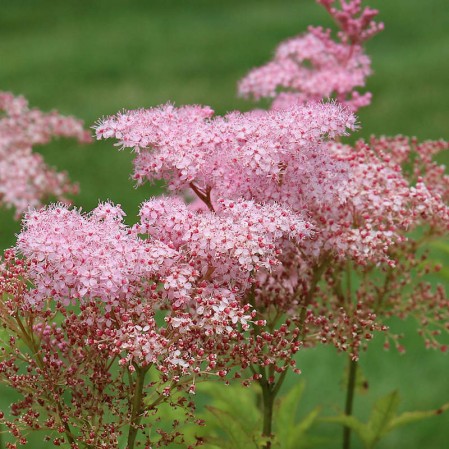Queen of the Prairie Seeds
Filipendula rubra
- HOW TO GROW
- FAST FACTS
HOW TO GROW
Sowing: Direct sow in late fall, planting the seeds just below the surface and lightly compacting the soil. For spring planting or starting indoors, mix the seed with moist sand and store it in the refrigerator for 90 days before direct sowing; keep the soil consistently moist until germination. These seeds germinate best at temperatures around 55 degrees F. Thin or transplant the seedlings. Transplanting should be done while the plants are small, since the taproot makes it difficult at larger sizes.
Growing: These plants do not tolerate drought well, and the soil should be kept consistently moist and rich. Dry soil or too much sun tends to damage the foliage, since this plant prefers cooler weather. When grown from seed, this plant will start producing flowers in its second year. Deadheading will not produce new flowers, though cutting back the plant will cause new growth of foliage. Mature plants can be divided in the fall after they have gone dormant; they will also self-seed and spread by rhizomes, though volunteer plants can easily be removed. This plant attracts bees and resists deer.
Harvesting: For fresh flowers, cut long stems of flowers that have just opened and place them in water immediately; strip the leaves that will fall below the water.
Seed Saving: After blooming, the flower head will develop clusters of seed heads that turn from green to red to brown. Remove entire seed heads when they have ripened to reddish brown, and spread them out to dry. Since the heads will not split, they must be crushed to remove the fine seed; however, they can also be planted without being cleaned. Separate the seed from the stems and store in a cool, dry place.
FAST FACTS
Latin Name: Filipendula rubra
Species Origin: US Native Wildflower
Type: Native Wildflowers
Life Cycle: Perennial
USDA Zones: 3, 4, 5, 6, 7
US Regions: Midwest, Northern, Northeast, Southeast
Seeds per Ounce: 16,200
Stratification: Cold/Wet for 12 Weeks
Germination Ease: Stratify 12 Weeks
Sunlight: Full Sun
Height: 60 Inches
Color: Pink
Bloom Season: Blooms Early Summer, Blooms Late Summer
Uses: Cut Flowers, Deer Resistant
DESCRIPTION

HOW TO GROW
Sowing: Direct sow in late fall, planting the seeds just below the surface and lightly compacting the soil. For spring planting or starting indoors, mix the seed with moist sand and store it in the refrigerator for 90 days before direct sowing; keep the soil consistently moist until germination. These seeds germinate best at temperatures around 55 degrees F. Thin or transplant the seedlings. Transplanting should be done while the plants are small, since the taproot makes it difficult at larger sizes.
Growing: These plants do not tolerate drought well, and the soil should be kept consistently moist and rich. Dry soil or too much sun tends to damage the foliage, since this plant prefers cooler weather. When grown from seed, this plant will start producing flowers in its second year. Deadheading will not produce new flowers, though cutting back the plant will cause new growth of foliage. Mature plants can be divided in the fall after they have gone dormant; they will also self-seed and spread by rhizomes, though volunteer plants can easily be removed. This plant attracts bees and resists deer.
Harvesting: For fresh flowers, cut long stems of flowers that have just opened and place them in water immediately; strip the leaves that will fall below the water.
Seed Saving: After blooming, the flower head will develop clusters of seed heads that turn from green to red to brown. Remove entire seed heads when they have ripened to reddish brown, and spread them out to dry. Since the heads will not split, they must be crushed to remove the fine seed; however, they can also be planted without being cleaned. Separate the seed from the stems and store in a cool, dry place.
FAST FACTS
Latin Name: Filipendula rubra
Species Origin: US Native Wildflower
Type: Native Wildflowers
Life Cycle: Perennial
USDA Zones: 3, 4, 5, 6, 7
US Regions: Midwest, Northern, Northeast, Southeast
Seeds per Ounce: 16,200
Stratification: Cold/Wet for 12 Weeks
Germination Ease: Stratify 12 Weeks
Sunlight: Full Sun
Height: 60 Inches
Color: Pink
Bloom Season: Blooms Early Summer, Blooms Late Summer
Uses: Cut Flowers, Deer Resistant





